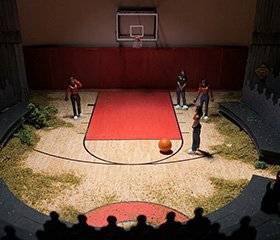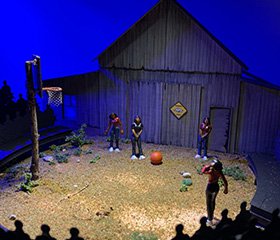The first scene of Flex, by Candrice Jones, takes place in the backyard basketball court of Starra Jones, the play’s principal character. “A lot of the play revolves around that dirt court,” said Matt Saunders, the production’s set designer, during a recent interview. “The court is part of the fabric of her identity. She needs to own that part of herself and embrace the fact that her roots are there.”
If the dirt court figures literally in the story’s physical setting, in small-town southeast Arkansas, it also has metaphorical implications. “There are a lot of locations in the play,” Saunders explained. “There’s a sleepover scene in a living room, a couple of scenes in a car. But because the dirt court is such a foundation of the young women as people, we decided that it would never really go away. Even when we move to a regional basketball tournament, and then the state tournament, and the space transforms, we’re still framed by the dirt court.”
Saunders, who previously worked with Flex’s director, Liliana Blain-Cruz, on Pipeline, also in the Newhouse, said that “a lot of time early in the design process was spent trying to decide where the dirt court’s basketball hoop should live in the space.”
“At one point,” Saunders commented, “we played the ball off the vom. Then we played it upstage left.” These solutions didn’t work, he said, “in part because there’s a real reality of stray basketball going into the audience. We had to mitigate against that as much as possible.”
To what structure would the hoop be attached? “A lot of the design period,” Saunders said, “was spent on researching just that question.” He explained: “We looked at barns and sheds, trying to strike the right tone. We didn’t want a shed saying that these are super-poor, oppressed girls. A dilapidated structure might have said that these girls are victims. There is an aspirational nature to the characters’ motivations.”
Classic red barns were considered. “But that felt too rural,” Saunders said – “too Charlotte’s Web.” Next up was a grey barn. “It was more of a shed,” he said. “But even that felt a little too run down, as if we were romanticizing something.” A corrugated metal shed was the ultimate decision. “That felt more real,” said Saunders.
As did the decision to make the overall set “fairly simple.” Saunders explained that “as a designer I try to get out of the way of everything but the characters and the storytelling.” He added: “That’s something I learned in graduate school at Yale, where I had the good fortune to study with Ming Cho Lee and Michael Yeargan.” And: “If you brought a sketch to class at Yale and you forgot to draw the person in the scene, the teachers wouldn’t even look at it. First you draw the actor, then the environment around it.”
Saunders has many reasons to be grateful for the Flex opportunity. It reunites him with his Yale friend and colleague, Blain-Cruz. It gives him a chance to work again on a play involving women’s sports: he designed The Wolves, about girls’ soccer, for a production at Swarthmore College, where he teaches. And Flex involves the sport about which Saunders is most passionate.
“Basketball is my favorite sport,” he said. “My daughter’s been playing since she was seven, and I coached her team when she was young.” (During the first weekend of Flex tech, Saunders’ family came up from Philly, where they are based. “My daughter had the thrill of shooting hoops with the cast,” Saunders said.)
And Saunders himself played the sport when he was younger. “I grew up in rural Virginia, on a farm. I played basketball on a dirt court. I’m very familiar with pounding that ball into the dirt, how it messes up your clothes and dries your skin out.” Saunders added: “So I have a visceral sense of what Starra in the play is going through on a day-to-day basis.” He added: “But in other ways this is not my story at all. Flex is the story of young black women -- a story that Candrice has told so eloquently.”
Brendan Lemon is a freelance journalist in New York.

